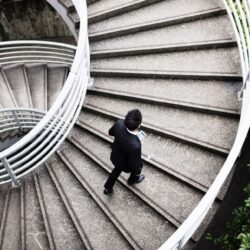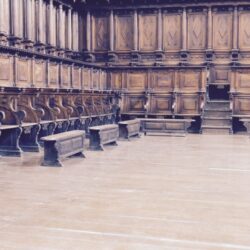The Fourth Amendment analysis of an OVI arrest occurs in three distinct stages: (1) the initial stop; (2) the request that the driver submit to field sobriety tests; and (3) the arrest. 1 This post discusses the first stage: the initial stop / vehicle in motion phase.
Since “routine” traffic stops have the propensity to expand into a search for more serious crimes, stops initiated upon probable cause of minor traffic violations are indeed a significant exception to the warrant requirement. Stopping an automobile and detaining its occupants constitute a ‘seizure’ within the meaning of the Fourth Amendment. 2 If an Officer lacked Constitutional Justification to stop a vehicle, any evidence or observations obtained after he activates his flashing lights is deemed fruit of the poisonous tree, and the State will be forbidden from using such evidence at trial. If you were charged with an Ohio OVI is absolutely imperative that you have an experienced Canton, Ohio DUI Lawyer evaluate whether the initial stop meets Constitutional standards.
Police officers have the authority to stop an automobile without a warrant if they possess probable cause that a crime or a traffic violation has occurred. 3 An officer has probable cause if he observes conduct which he reasonably believes violates the law. 4 Judicial review of a stop based on probable cause requires an objective assessment of the facts and circumstances then known to the officer. 5
The officer’s subjective state of mind is irrelevant to the probable cause analysis. 6 Thus, police officers may use stops for minor traffic violations 7 as a pretext to search for more serious crimes. 8 If an officer observes something as minor as a burned-out license plate light, the officer has full authority to stop the vehicle based on probable cause of an equipment violation. 9
How can a Canton, Ohio DUI Lawyer help?
When you contact Grimsely Offineer, LLC an experienced Canton DUI Lawyer will undergo an in-depth investigation and evaluation of the Constitutionality of the initial stop. Your attorney already has widespread familiarity with the various traffic and equipment violations Police Officers attempt to use as their reason for the stop. 10 Moreover, our Canton DUI attorneys are very proficient in finding case law where Judges have interpreted the traffic code and determined that the facts alleged by the officer actually did not constitute a traffic violation.
For example, suppose the officer’s police report indicates that he observed the defendant commit an infraction in violation of OHIO REV. CODE ANN. § 4511.33. Rules for driving in marked lanes, and that gave him Probable Cause to stop the vehicle. A good DUI lawyer will make a written Demand for Discovery pursuant to Rule 16 of the Criminal Rules of Procedure to obtain a copy of the Officer’s dash-cam video recording of the stop. When the OVI lawyer watches the video, he discovers that his client’s left vehicle tires drove on top of the double yellow line on two separate occasions, but they did not actually cross the double yellow line.
A DUI Lawyer at Grimsley Offfineer, LCC will conduct legal research to find binding case law which addresses whether touching marked lanes without crossing them constitutes a violation. He will discover that it does not constitute a violation and he will file a Motion to Suppress Evidence stating in part:
The Patrolman stopped Defendant’s vehicle for an alleged Marked Lanes Violation. Defendant maintains, and the video evidence confirms, that her tires merely touched lane makings and never actually crossed over any lines. Moreover, Defendant states that she was driving a very large pickup truck. Accordingly, she drove as nearly as is practicable within her lane of travel as the statute proscribes. The Court of Appeals holds that an officer does not have probable cause or reasonable suspicion to stop a vehicle when the vehicle’s tires briefly touch the line dividing the lanes without crossing over the line because such conduct does not constitute a violation of R.C. 4511.33. Wickliffe v. Petway, (11th Dist. 2012) 2012–Ohio–2439; State v. Lisac (2012), 2012-Ohio-5224 (Court found the officer lacked probable cause to stop where the vehicle’s tires touched, but did not cross, the center line). Furthermore, Defendant’s vehicle remained on the right half of the roadway the entire time she was driving as required by R.C. 4511.25. State v. Thayer (Ohio App. 9th Dist. 2012), 2012-Ohio-3301, ¶20 (no evidence of violation of R.C. 4511.25 where motorist drove on top of double yellow line twice.).
The initial seizure of Defendant was accomplished in the absence of any reasonable and articulable suspicion or probable cause that Defendant violated, was violating, or was about to violate any law or that Defendant’s vehicle was otherwise subject to seizure. Thus, the seizure violated Defendant’s rights under the Fourth and Fourteenth Amendments to the United States Constitution and Article I, Section 14 or the Ohio Constitution.
Judicial approval of a warrantless seizure based on probable cause comes in hindsight, and if an officer makes an unreasonable seizure, the evidence obtained must be suppressed under the exclusionary rule. Terry v. Ohio (1968), 392 U.S. 1. “The scheme of the Fourth Amendment becomes meaningful only when it is assured that at some point the conduct of those charged with enforcing the laws can be subjected to the more detached, neutral scrutiny of a judge who must evaluate the reasonableness of a particular search or seizure in light of the particular circumstances.” Id. at 12. The very purpose of the exclusionary rule is to deter police from violating the Fourth Amendment in their efforts to obtain evidence. Id. Courts exclude such evidence to prevent becoming a party to lawless police conduct. Id.
Unlike other criminal proceedings, at a suppression hearing the State is on trial, so to speak. In order to prevail, the State must prove by a preponderance of the evidence that the officer did not infringe upon the Defendant’s Constitutional rights. As sole guardian of our Constitutional rights, the Court must be careful to neutrally evaluate the evidence in this matter with an understanding that both parties are alleged to have violated the law. Finally, the court must exclude all evidence that derived from an unconstitutional search and seizure.
Based on the above facts and argument of law, Defendant respectfully requests that this Court grant her motion to suppress and exclude evidence in limine, in its entirety.
- State v. Richards (Oct. 15, 1999), 11th Dist. No. 98-P-0069, 1999 Ohio App. LEXIS 4860, *5.
- Delaware v. Prouse, 440 U.S. 648, 653 (1979)
- Dayton v. Erickson, 665 N.E.2d 1091, 1092 (Ohio 1996). “Where a police officer stops a vehicle based on probable cause that a traffic violation has occurred or was occurring, the stop is not unreasonable under the Fourth Amendment to the United States Constitution.” Id.
- Beck v. Ohio, 379 U.S. 89, 91 (1964). “Probable cause has been defined as a ‘fair probability’ that criminal activity is afoot.” State v. Wilcox, 895 N.E.2d 597, 602 (Ohio App. 2 Dist. 2008) (citing State v. George, 544 N.E.2d 640 (1989)). Probable cause has also been defined as ‘facts and circumstances within [an officer’s] knowledge . . . which were sufficient to warrant a prudent man in believing that the [suspect] had committed or was committing an offense.” Id.
- Erikson, 665 N.E.2d at 1094.
- Erikson, 665 N.E.2d at 1094; Whren v. United States, 517 U.S. 806, 806 (1996) (“Subjective intentions play no role in ordinary, probable-cause Fourth Amendment analysis.”).
- State v. McCormick, No. 2000CA00204, 2001 WL 111891, at *3 (Ohio App. 5 Dist. Feb. 5, 2001) (“The severity of the violation is not the determining factor as to whether probable cause existed for the stop.”).
- Erikson, 665 N.E.2d at 1097 (“[W]here a police officer stops a vehicle based on probable cause that a traffic violation has occurred or was occurring, the stop is not unreasonable under the Fourth Amendment to the United States Constitution even if the officer had some ulterior motive for making the stop, such as a suspicion that the violator was engaging in more nefarious criminal activity.”); State v. Shupe, No. H-95-025, 1996 WL 520086, at *2 (Ohio App. 6 Dist. Sept. 13, 1996) (“[E]ven if the stop is a pretext for the officer to check for more serious crimes, the stop is constitutionally valid.”).
- See OHIO REV. CODE ANN. §4513.05 (LexisNexis through legislation filed Sept. 1, 2008) (“[A] separate light shall be so constructed and placed as to illuminate with a white light the rear registration plate, when such registration plate is required, and render it legible from a distance of fifty feet to the rear.”). As indicated by the numerous cases based on such stops the missing license plate light is a golden ticket to DUI stops. See, e.g., State v. Wilcox, 2008 Ohio 3856 (Ohio. App. 2 Dist. 2008); Village of Kirtland Hills v. Strogin, 2006 Ohio 1450 (Ohio. App. 11 Dist. 2006); State v. Rogers, 2005 Ohio 5358 (Ohio App. 6. Dist. 2005); State v. Simmons, 2005 Ohio 3428(Ohio App. 8. Dist. 2005); State v. Strawder, 2004 Ohio 6813 (Ohio App. 7 Dist. 2004); State v. Weinheimer, 2004 Ohio 801 (Ohio App. 12 Dist. 2004); State v. Reese, 2003 Ohio 2638 (Ohio App. 9 Dist. 2003); State v. Held, 766 N.E.2d 201 (Ohio App. 11 Dist. 2001); Wilmington v. Conner, 761 N.E.2d 663 (Ohio App. 12 Dist. 2001); State v. Cullers, 695 N.E.2d 314 (Ohio App. 2 Dist. 1997).
- See Whren v. United States, 517 U.S. 806, 818-19 (1996) (There are a “‘multitude of applicable traffic and equipment regulations’. . . so large and so difficult to obey perfectly that virtually everyone is guilty of violation, permitting the police to single out almost whomever they wish for a stop. But we are aware of no principle that would allow us to decide at what point a code of law becomes so expansive and so commonly violated that infraction itself can no longer be the ordinary measure of the lawfulness of enforcement. And even if we could identify such exorbitant codes, we do not know by what standard (or what right) we would decide . . . which particular provisions are sufficiently important to merit enforcement. For the run-of-the-mine case, which this surely is, we think there is no realistic alternative to the traditional common-law rule that probable cause justifies a search and seizure.”). Every officer is equipped with an arsenal of traffic infractions to stop you with, including but not limited to: OHIO REV. CODE ANN. § 4511.33. Rules for driving in marked lanes; OHIO REV. CODE ANN. § 4511.25. Lanes of travel upon roadways ; OHIO REV. CODE ANN. § 4511.34. Space between moving vehicles; OHIO REV. CODE ANN. § 4511.36. Rules for turns at intersections; OHIO REV. CODE ANN. § 4511.251. Street racing; OHIO REV. CODE ANN. § 4511.26. Vehicles traveling in opposite directions; OHIO REV. CODE ANN. § 4511.27. Rules governing overtaking and passing of vehicles; OHIO REV. CODE ANN. § 4511.28. Permission to overtake and pass on the right; OHIO REV. CODE ANN. § 4511.29. Driving to left of center line; OHIO REV. CODE ANN. § 4511.30. Prohibition against driving upon left side of roadway; OHIO REV. CODE ANN. § 4511.31. Hazardous zones; OHIO REV. CODE ANN. § 4511.32. One-way highways and rotary traffic islands; OHIO REV. CODE ANN. § 4511.35. Divided roadways; OHIO REV. CODE ANN. § 4511.37. Turning in roadway prohibited; exception for emergency or public safety vehicle; OHIO REV. CODE ANN. § 4511.38. Rules for starting and backing vehicles; OHIO REV. CODE ANN. § 4511.39. Turn and stop signals; OHIO REV. CODE ANN. § 4511.40. Hand and arm signals; OHIO REV. CODE ANN. § 4513.03. Lighted lights and illuminating devices required; OHIO REV. CODE ANN. § 4513.04. Headlights; OHIO REV. CODE ANN. § 4513.05. Tail lights and illumination of rear license plate; OHIO REV. CODE ANN. § 4513.06. Red reflectors required; OHIO REV. CODE ANN. § 4513.071. Stop lights; OHIO REV. CODE ANN. § 4513.08. Obscured lights on vehicles; OHIO REV. CODE ANN. § 4513.10. Lights on parked vehicles; OHIO REV. CODE ANN. § 4513.13. Cowl, fender, and back-up lights; OHIO REV. CODE ANN. § 4513.14. Two lights displayed ; OHIO REV. CODE ANN. § 4513.15. Headlight illumination requirements; protection of oncoming drivers; high beam indicator; OHIO REV. CODE ANN. § 4513.16. Lights of less intensity; OHIO REV. CODE ANN. § 4513.17. Number of lights permitted; direction of beam; flashing, oscillating or rotating lights; OHIO REV. CODE ANN. § 4513.19. Focus and aim of headlights; OHIO REV. CODE ANN. § 4513.242. Display of security decal on side window or sidewing; OHIO REV. CODE ANN. § 4513.26. Safety glass required; OHIO REV. CODE ANN. § 4513.261. Directional signals; OHIO REV. CODE ANN. § 4511.41. Right-of-way at intersections; OHIO REV. CODE ANN. § 4511.42. Right of way when turning left; OHIO REV. CODE ANN. § 4511.43. Right-of-way at through highways; stop signs; yield signs; OHIO REV. CODE ANN. § 4511.431. Stop at sidewalk area; OHIO REV. CODE ANN. § 4511.432. Stop signs on private residential road or driveway; OHIO REV. CODE ANN. § 4511.44. Right of way on public highway; OHIO REV. CODE ANN. § 4511.441. Pedestrian on sidewalk has right-of-way; OHIO REV. CODE ANN. § 4511.451. Funeral procession has right of way; OHIO REV. CODE ANN. § 4511.46. Pedestrian on crosswalk has right-of-way; OHIO REV. CODE ANN. § 4511.47. Right of way yielded to blind person; OHIO REV. CODE ANN. § 4513.22. Mufflers; excessive smoke or gas; OHIO REV. CODE ANN. § 4513.221. Regulation of vehicle and engine noise in unincorporated areas; OHIO REV. CODE ANN. § 4513.23. Rear view mirrors; OHIO REV. CODE ANN. § 4513.24. Windshields and wipers; OHIO REV. CODE ANN. § 4513.241. Restrictions on use of tinted glass and other vision obscuring materials.





